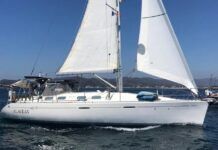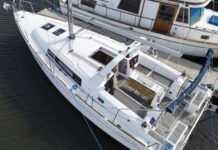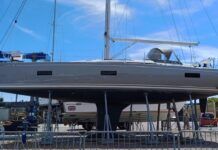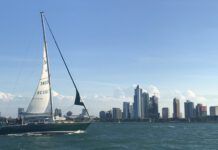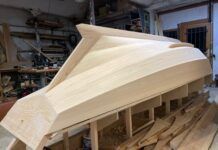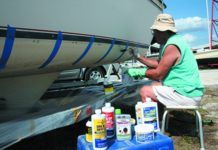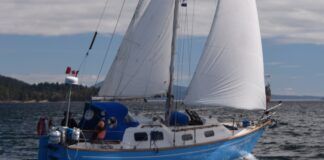One Tough Lafitte 44
Hurricane Charlie, the second of three hurricanes to hit Daytona Beach, Fla., in 2004, found my 1982 Lafitte 44 at an anchorage on the Intracoastal Waterway, just south of Daytonas three bridges. My anchors held. But a series of calamitous events resulted in Twilight breaking free, then washing ashore at the foot of a riverfront apartment complex.
She was on a sandy beach, but her bow overhung a low concrete rip-rap seawall that had been reinforced with steel rebar. As the boat swung about in the storm
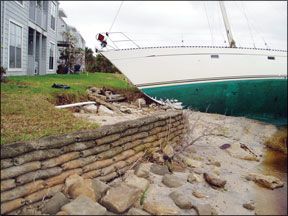
288
surf, she demolished about 20 feet of the sea wall, knocking down the rip-rap and bending the reinforcing steel. There was some abrasion to the boats hull but, more than anything else, the damage was cosmetic. Her hull was not penetrated.
Mac Smith
Twilight, Lafitte 44
Daytona Beach, Fla.
Snubber for the Snubber
Regarding your recent discussion of heat-related failure of dock and mooring lines at the bow chocks (“Nylon Rope Endurance Test,” December 2007, and Mailport, January 2008): My anchor cleats are more than 2 feet behind the bow chocks. My working tackle is 150 feet of chain on a Delta anchor. The other end of the chain has 250 feet of 5/8-inch, three-strand nylon. Seldom does the nylon get out of the anchor locker. Normally the chain is fastened to the boat via a chain hook on one end of a length of 1/2-inch nylon. This makes an effective shock absorber. However, as you can imagine, with the large distance between chock and cleat, it would not take much wave action for the line to “saw” several inches at the cleat, making its life short. This problem is avoided by a short piece of 7/8-inch Dacron with an eye on each end. One eye goes on the deck cleat. A bowline is used to attach the pendant to the second eye, which is overboard. The thicker, less elastic Dacron tends to resist abrasion better.
Ed Weber
Sea Serpent, Freedom 38
Port Ewen, N.Y.
Jabsco Joker Valve
We had a Jabsco Compact head and pump on our previous boat, a 1988 Hunter 35, and have one on our current boat, a 2005 C&C 115, and have only one major complaint: the tri-corner joker valve. It caused us problems on both boats until we
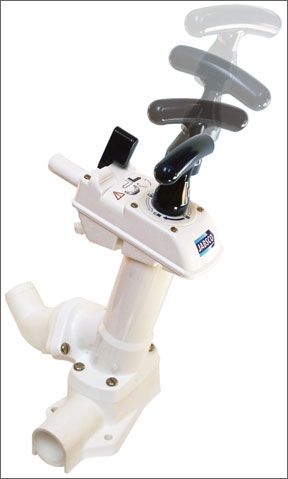
288
replaced it with the Raritan joker valve, and we have experienced no problems since then. The Raritan joker valve is a duck-billed valve that works fine and fits well. I highly recommend this adjustment to the Jabsco system.
J.A. Frix
Canvas Caper, C&C 115
Herndon, Va.
Jabsco has come out with a new pump design that may help resolve this problem. According to Jabsco, some new boat designs are installing tanks higher, putting excess pressure on the joker valves. In some instances, this can cause waste water to slowly drain back into the bowl. The new Twist-N-Lock handle/pump, which effectively closes the valve with a twist of the pump handle, is designed to eliminate this problem.
Raritan Update
I have a Raritan PHII head. The original one was replaced after 14 years of moderate use. It has been great, but the main problem is that the connection between the pump piston and handle will break, and this part is not included in the offered repair kit. And unlike a leaking joker valve, etc., once this part breaks, you can’t use the head! In fact, the main reason I replaced the old head (with a new PHII) is that just before a two-month cruise, this part broke and I couldnt get a replacement at the local West Marine, (but I could buy a new head!) and I didnt have time to order the part. Raritan should include this vital part in the repair kit.
Frederick Dennstedt
Chevere II, Endeavourcat 30
Flagstaff, Ariz.
Another reader, Peter Verne of New York, N.Y., also reported his yoke breaking on his Raritan-again it was after several years of use. He said he replaced the piston-rod yoke with a bronze one, which, according to Raritan, is no longer in stock. Raritan considered including this component in its repair kit, but said the kit is designed to contain rubber parts that typically need to be replaced. You can buy the yoke and other parts individually; we found it for $28 at
www.defender.com. Raritan changed the linkage design in 1993 to include a set screw to help hold the piston-rod yoke in place. Raritan advises users to apply the threadlock Vibra-tite to this screw (www.threadlockers.com/vibratite.jsp) each time the yoke is taken off to replace rubber parts. Until recently, Raritan included Vibra-tite with each new piston-rod yoke but not in the repair kit. However, as a result of our readers input, Raritan is now including Vibra-tite in the repair kits. Cruising sailors with older Raritans who will be away from regular supply channels may want to consider adding a spare yoke to their inventory.Oil That Pump
Pump lubrication is the key for reasonable service from a Jabsco head, and with current models, its easily accomplished. However, in my own experience, using the right lubricant is critical. I have tried a variety over the years, including the
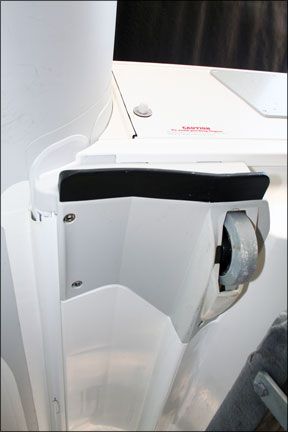
288
recommended one and have found that none will last over a few months, except for the one touted by head queen Peggy Hall: Super Lube Teflon Lubrican’t (3-ounce tube, $10, www.west
marine.com). I cannot put too fine a point on using it; it will simply save you many headaches and possibly hundreds of dollars in pump replacements.
Rick Dinon
Hunter Legend 40.5
Shoreline Marina, Calif.
Walker Bay and KVH
With reference to the review of the Walker Bay Genesis rigid inflatable (December 2007): A couple of years ago, I purchased the 8-foot Walker Bay Genesis and have had two problems: The integrated wheel is useful only on hard, non-sandy surfaces. If there is anything around that can get into the small space between the wheel and its housing, it will, jamming things up thoroughly. At that point, the wheel is useless.
The drain plug at the aft end of the boat used to let water in rather than out. The Walker Bay folks were nice enough to send me a new drain, which I installed. It still leaked. So I have gooped it up, making it impossible for water to get through in either direction.
Also, regarding the hand-bearing compasses article in the February 2008 issue: Ive owned a KVH DataScope for many years and cannot say enough good things about its accuracy and many features. However, the three quarter-sized lithium batteries that power it do not last all that long and are quite expensive to replace. Also, it is difficult to use when the boat is bouncing around since you are, in essence, looking through a five-power telescope with a limited field of view. Under those conditions, I find that using a hockey-puck compass is better.
Jim Keene
Quickstep 24
Seal Cove, Maine
Walker Bay does not recommend plugging up the drain, which is meant to prevent the boat from over-filling with water.
Wheres The Sabre 30?
When I saw that the February 2008 cover article was about 30-foot classics, I immediately looked for my own, a Sabre 30 MkIII. Alas, it was not to be found. I often wonder why I never see the Sabre 30 featured in any sailing publication. It is a remarkable production boat. Well constructed, seaworthy, and relatively fast, even by todays standards. I know Ive sailed many an enjoyable and safe passage, even in lousy weather, without ever feeling she is not up to the task. I would love to see the Sabre 30 get a little attention someday.
Bob Thomas
Sabre 30
Ridgefield, Conn.
Introduced in 1979, the Sabre 30, seemed to fit better with boats of the 1980s, which we will be looking at in a future issue.
Navigation
Regarding your recent article on navigation (“Navigation, A Lost Art,” December 2007): The Queen Elizabeth 2 was not the ship that automatically DR-ed onto a shoal. That was a Greek cruise ship returning from Bermuda to Boston. The problem was that a cable was undone between the GPS and the integrated navigation system. This would be a non-issue if anyone on watch could see the nav computer, but it was in a room behind the bridge. I assume, but don’t know, that it would have been blinking its display to indicate a problem.
The QE 2 incident was entirely different. The skipper and the pilot knew exactly where they were, but were misled by the NOAA chart, which used an incomplete survey from the 1930s. If you look at the (now-historical) chart, you see a regular rectangular grid of soundings, with no infill soundings at all, even though there is a rise in the bottom. I hope before and after copies of this chart are now used at maritime academies everywhere.
Rodney Myrvaagnes
J/36
New York, N.Y.
We apologize for the reporting error. The actual details related to both cases help bolster our argument for preserving and practicing traditional navigational skills in the age of electronic navigation. The loss of GPS coverage due to a cable or network failure on the Greek ship brings up an interesting point regarding navigational alarms and how marine electronics manufacturers are handling the various alarm functions ranging from depth alarm to loss of GPS coverage. We are currently researching this topic for a future story.
A Cheeky Suggestion
Ive just read your article on hand-bearing compasses, and speaking as one who used the devices to a great degree back in the “bad old days” (before Loran A or C and before SatNav and GPS) on quite a few-hundred-mile races from Gulfport,
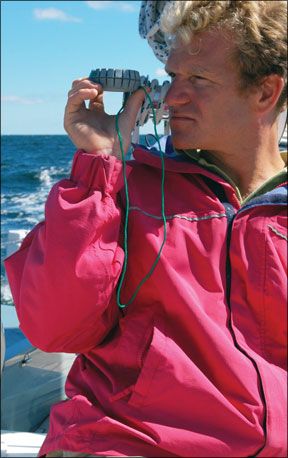
288
Miss., to Pensacola, Fla., and on any number of 200-mile races from Gulfport to the Mobile, Ala., sea buoy to the MRGO light (the light ship on several races) and back to Gulfport, I can tell you that the best way to use the hockey puck is against the cheek and with both eyes open. Additionally, two more areas should be considered. The best pucks have the “tritium” lighting and can be used day or night without any preparation. The second item of desirability is the ability to read a bearing by looking down on the puck, particularly when navigating on a boat without a telltale compass at the nav station.
Now, Ive got some Steiner Commanders as a replacement to my Tasco hand-bearing glasses. This is really the best approach.
In passing, however, if hand-bearing glasses are purchased, be sure to ascertain which is your dominant eye. Mine is the right eye, and those with a left-mounted compasses are difficult for me to use.
Thanks again for a fine publication. Even though Im going over to the “Dark Side” and about to buy a trawler, sailing and those who sail will always be in my thoughts.
V.N. Tanner
Bay St. Louis, Miss.
Compasses and Glasses
I had a close call once with a hockey puck and my wifes glasses.
They were metal-framed glasses and created an approximately 20-degree difference in the compass readings. Fortunately, I didnt wear glasses at the time, and since we were getting different readings, we slowed till we figured out why.
However, now the hockey puck doesn’t focus as well with my old eyes. Seems to me more cruisers are tending to be baby boomerish, and we now have different concerns for reading these compasses than we did when we were younger.
Dave and Wendy Kall
Elysium, Westsail 42
Bird Battles
This past summer, we had a terrible time with cormorants sitting on the spreaders and absolutely coating the boat with their droppings. And on a nonskid deck, the droppings become almost impossible to get off.
To combat this, a number of us have had success with stringing sets of small pennants up the mast and tying the ends off on the deck, forming a “V” behind the mast. This puts a line of fluttering flags behind each spreader. It seems the birds fly onto the spreaders from the stern, approaching from below the spreader and swooping up onto it. The flags distract them but also get in their way, so they don’t try to land there. This does not help with them sitting on the bow pulpit, of course, but at least then most of the obnoxious stuff falls in the water or on the anchor. An added benefit is the boat looks a bit dressy, too.
Chuck Parker
Catalina 36MK II
Atlantic Highlands, N.J.





